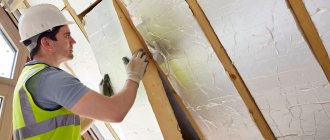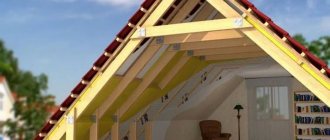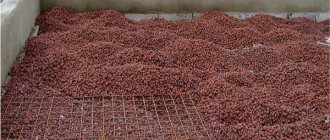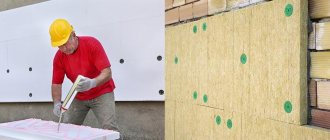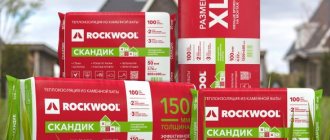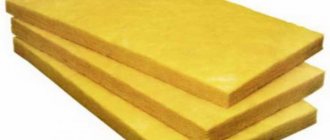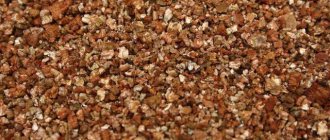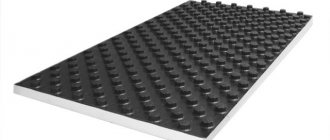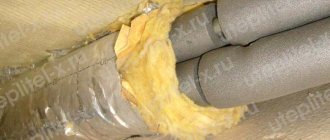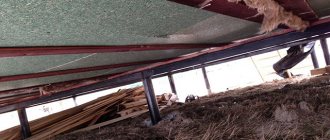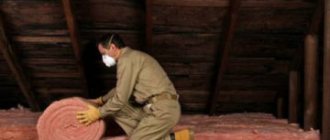General requirements for thermal insulation for roofs
The selection of optimal insulation for the roof is carried out according to a number of criteria.
- Coefficient of thermal conductivity. For most modern thermal insulation materials, this figure is below 0.04 W/m·K. This is quite enough to use a small layer of thermal insulation, even in the harsh domestic climate.
- Density. The indicator is inversely proportional to the thermal conductivity coefficient. How close it can be placed to building structures depends on the density of the thermal insulation material. The absence of cracks prevents the appearance of cold bridges, the formation of condensation, and damage to insulation and building structures.
- Weight. Quite a wide range of indicators from 15 to 300 kg/m². When insulating a wooden or prefabricated panel house with a pitched and mansard roof, it is recommended to use lightweight materials so as not to have a critical impact on the load-bearing structures. More durable structures made of solid brick, reinforced concrete monolithic and prefabricated structures can withstand significant loads. They use heavier insulation.
- Moisture absorption. Absorption of condensed or atmospheric moisture by insulation reduces its thermal insulation parameters. For such materials it is necessary to provide a waterproofing and vapor removal system.
- Vapor permeability. A complete lack of vapor permeability can lead to stagnation of warm, humid air and the formation of mold. High vapor permeability will reduce protection from cold air masses and require additional wind insulation.
- Flammability. For structures made of wood, it is better to choose non-flammable thermal insulation materials. However, even brick and concrete buildings have pitched roofs, in most cases made of wood. For flat roofs made of concrete slabs, the use of combustible insulation is quite acceptable.
- The degree of shrinkage and the ability to maintain the original shape. Due to the deformation of the material during operation, voids and cracks can form, and on steep pitched roofs, distortions can occur, reducing the effectiveness of thermal insulation.
- Soundproofing. A key parameter, especially on “noisy” roofing materials: metal profiles, metal tiles, etc. Reduces background noise during rain and hail.
- Easy to install. An important parameter that allows you to carry out some or all of the roof insulation work yourself. In addition, important qualities are: the need to use specialized equipment, as well as the formation of residues that cannot be used.
Forgotten insulation materials: ecology is back in fashion!
For many, the issue of ecology today is one of the most important. As studies of individual eco-projects show, in a modern house made of the same modern materials, the air can be so toxic that its harmfulness is almost no different from the toxicity of a busy highway. And almost every modern buyer, armed with the Internet, tries to study the issue of health safety of the construction or repair he has undertaken.
However, the idea is great: read reviews about this or that product, carefully study the composition and the possibility of combination with other materials, and even conduct your own test. And yes, arm yourself with the firm confidence that you need to purchase everything you need for construction only from trusted suppliers!
But, if not for the “but”... The fact is that environmental friendliness is not enough even in expensive foreign insulation materials. With rare exceptions, such as basalt wool. In general, the picture of allergy sufferers (and there are more and more of them lately) is not at all encouraging. Therefore, today the fashion for old, unfairly forgotten “old-fashioned” methods of roof insulation is returning again, and it is the owners of expensive houses and cottages who boast about them.
Expanded clay: an unfairly forgotten technology
Expanded clay is an artificial stone that is obtained from baked clay. It is absolutely not afraid of moisture, is not susceptible to organic matter and does not require any vapor barriers (the main problem of roof insulation has been solved!). And at the same time, it is not flammable.
But this wonderful technology is gradually becoming a thing of the past!
Sawdust: does not burn, does not rot, does not settle
Let’s immediately make a reservation about the flammability of sawdust: only fresh sawdust burns, and you can actually use it to heat a stove in a bathhouse. But rotten ones that have been lying around for a year cannot even be set on fire. This is the type of sawdust that is used to insulate the roof.
It’s surprising, but you can still find old houses with attics insulated with sawdust over clay. Moreover, the sawdust itself, after almost a century, does not even change color! This is why experts conclude that with proper preparation, sawdust can serve as insulation for a very, very long time. And is it worth reminding that such insulation is the most environmentally friendly of all existing ones.
Only modern ecowool, which is made from recycled newspapers, is close to the composition of sawdust, and those at one time were made from cellulose fiber. But here, too, there is a certain percentage of the same printing ink, while sawdust contains no harmful substances at all. In addition, ecowool is additionally treated with boron and other similar substances so that it is not flammable and does not rot.
Reeds, straw and reeds: double benefits
Until recently, roofs were practically not covered with reeds or thatch, even in the most remote hinterlands. The exception is houses specially designed for eco-style or the popular “hobbit house”. But it turns out that the fashion for the old is a profitable business: all over the world it is now becoming increasingly popular to make the roof of a house from reeds and straw. And, as it turned out, this material has a lot of advantages not only as a covering, but also as a roofing insulation. Plus great aesthetic features:
Despite the complexity of harvesting the stems of a reed plant for making a roof, this know-how has many advantages:
- Absolutely environmentally friendly. The stems of the sedge family have a unique structure, which is close in its properties to wood, but at the same time it does not experience the negative influence of the environment. This is partly due to the fact that stems that are about a year old are used for the roof, and during this time the plant simply does not have time to accumulate harmful radicals. Like bamboo, which grows in just 5 years and is recognized as much more environmentally friendly than wood. Of course, an ordinary tree has been growing for decades!
- Purity of the material. In preparation for laying, reed stems are not treated with any chemicals or carcinogens.
- Strength and stability. Because the reed itself grows in swampy areas, but it is not afraid of moisture, sun, or frost. And during its entire service life, the reed is not deformed by precipitation, because it is natural for it.
- Excellent insulation. With such a coating, no insulation is needed at all - the reeds are insulation, two in one.
And the technology for working with such materials is actually not complicated. Here, for example, is how roofs were insulated with straw in ancient times:
And here’s how modern roofs are insulated with straw and wood chips:
As you can see, nothing complicated! Good luck to you in any endeavor!
Types of thermal insulation for roofs
Conventionally, all insulation materials can be divided into natural and synthetic. Their environmental friendliness and efficiency largely depend on this parameter. In this review we will not touch on exotic thermal insulation made from reeds, reed or straw mats.
Glass wool
It has a fibrous structure; inorganic raw materials, also used in glass production, are used for production. Glass wool is resistant to mold, mildew and rot. One of the few insulation materials that does not harbor rodents. It has high heat and sound insulation parameters combined with an affordable cost. Disadvantages include the need to use personal protective equipment during installation, as well as the need for careful isolation from residential premises - as a rule, a vapor barrier film is used for this. Thermal conductivity – 0.035-0.044 W/mK.
When installing glass wool, it is necessary to use personal protective equipment: tight overalls, gloves, goggles, respirator PHOTO: lh3.googleusercontent.com
Mineral wool, basalt wool
Basalt (stone) wool is actually mineral wool, but with improved manufacturing technology and higher quality raw materials from volcanic rocks (basalt, diabase). It is more resistant to mechanical loads. The material is more durable than glass wool. Produced in both rolls and slabs. The recommended density for insulating non-load-bearing roof structures varies from 30 kg/m³ to 40 kg/m³. For flat roofs that are loaded but not in use, it is better to use denser grades of 45-60 kg/m³. With appropriate strengthening and waterproofing, they can withstand technical movements and snow regulatory loads. Thermal conductivity – 0.032-0.048 W/m K
Mineral and basalt wool are visually difficult to distinguish from each other for a non-professional. When purchasing, request a certificate of conformity PHOTO: i.ytimg.com
Important! The service life of mineral wool, according to manufacturers, is 25-30 years. Basalt is a little older – up to 35 years old. However, in harsh climatic conditions it is much less and for roofing structures it actually lasts no more than 20 years. After which the effectiveness of thermal insulation begins to decline sharply.
Ecowool
The material consists of specially processed cellulose, usually recycled paper, an adhesive mixture with antiseptic and flame retardant additives in a ratio of 81% to 19%. Externally, the insulation is a loose mass of dry flakes. Manufacturers position the material as a universal, and most importantly, environmentally friendly means for insulating all building structures of the house.
The process of laying ecowool in niches of the roofing structure PHOTO: fasad-exp.ru
It is used for insulating attics and backfilling attic floors - horizontal non-load-bearing surfaces (between joists) and used attics. Blowing technology is used to insulate rafter structures. Using special equipment, ecowool is blown into the space between the rafters or joists.
Expert's point of view
Dmitry Kholodok
Technical director of repair and construction
Ask a Question
“Despite the manufacturers’ assurances, the material shrinks quite a lot, especially in vertical and inclined structures.”
Styrofoam
To insulate attic structures and roofs, two types of foam can be used:
- For pitched - ordinary polystyrene foam PPS-25...PPS-35;
- For flat - extruded foam plastic (penoplex), with a density from 32 kg/m³ to 45 kg/m³.
The thermal conductivity of the entire class of insulation based on polystyrene foam is 0.38-0.41 W/m K. The advantages of this material include:
- durability, while performance properties are not lost throughout the entire service life;
- resistance to mold, mildew, rotting, and corrosion processes;
- completely hydrophobic - does not get wet and practically does not absorb moisture;
- light weight - no need to strengthen supporting structures;
- the ability to cut with a simple knife, the low elasticity of the material allows for quick installation;
- good sound insulation characteristics;
- affordable cost - one of the cheapest thermal insulation materials.
Typically used for insulation of roof structures in open installation technologies, when all layers of the roofing pie are mounted outside the building PHOTO: teplo.guru
Disadvantages of polystyrene foam and insulation based on it:
- release of carcinogenic substances. Depending on the specifics of the production process, they may exceed the norm, so when purchasing, you must request an appropriate certificate from the seller;
- high flammability combined with the active release of toxic substances during combustion;
- complete tightness - insulated structures become vapor-tight, therefore attic and attic spaces insulated with foam plastic require a forced ventilation system.
When using polystyrene foam as insulation, there is no need for additional vapor barrier PHOTO: utepleniedoma.com
Related article:
Penoplex: technical characteristics. By selecting slabs of suitable thickness, you can ensure a sufficient level of thermal insulation of walls, floors, and ceilings. Let's talk about this insulation in more detail in our review.
Penofol, penotherm
This thermal insulation material is a composite based on low-density polyethylene foam and one (Penofol) or two (Penotherm) layers of foil. The thermal conductivity of such insulation, compared to thick-layer materials, is not so high and amounts to 0.049 - 0.053 W/m K. However, the insulation effect in attic rooms appears due to the reflection of infrared radiation into the room. To do this, the insulation is mounted with the reflective side facing the living space. And between it and the inner surface of the rough coating a technological gap of 3-5 cm is formed.
When laying penofol or penotherm, all joints between the canvases are sealed with special metallized tape PHOTO: i.ytimg.com
Polyurethane foam
The use of polyurethane foam as insulation for attic and roof structures involves the use of the spraying method. Thanks to this method, a seamless layer is created that does not require compaction, sealing of cracks and cross-laying of slabs. Has the following parameters:
- thermal conductivity coefficient 0.029 - 0.041 W/m K;
- density 70 kg/m³;
- durability up to 30-35 years without reducing basic qualities.
Using polyurethane foam as insulation under roofing material PHOTO: orchardo.ru
To spray polyurethane foam, you need to have special, expensive equipment, thanks to which the insulation of roof structures is carried out in a few hours. In addition, the cost of insulation itself is much higher than that of conventional polystyrene foam.
Spraying can be carried out along the base of the roof without additional water and wind insulation PHOTO: i.ytimg.com
Important! By analogy with polyurethane foam, a technology for spraying mineral wool was developed - “cotton blanket” (blowing). This method has all the advantages of polyurethane foam spraying, but is environmentally friendly.
The process of applying “blown-in” mineral wool PHOTO: ekassiltinasana.lv
Expanded clay
Environmentally friendly thermal insulation material consists of small balls of baked clay. It has extremely low moisture absorption, is non-flammable, and vapor permeable. The thermal conductivity coefficient of expanded clay, depending on the fraction, is 0.1 - 0.18 W/m·K, with a density of 250 to 800 kg/m³. As can be seen from these indicators, expanded clay has rather mediocre thermal insulation parameters. Therefore, to obtain the desired insulation effect, it must be used in a thicker layer. As a rule, it is used as a filler for cement screeds on horizontal roof surfaces.
Unused attics are insulated with expanded clay using the bulk method PHOTO: 1nerudnyi.ru
Sawdust
In its effect, as well as in the composition of thermal insulation, roof insulation with sawdust almost completely replicates ecowool. However, if ecowool is treated with boron to obtain resistance to rotting and burning, then it is not recommended to process sawdust. In this regard, such insulation requires particularly careful hydro- and vapor barrier. Sawdust is susceptible to rotting and fungus, so the attic space must have good ventilation.
Using sawdust for roof insulation when repairing roofing PHOTO i.ytimg.com
As a rule, sawdust is laid on horizontal surfaces in the structure between the joists or on pitched roofs with a small angle of elevation. At the same time, the shrinkage coefficient of the material is minimal. Another undoubted advantage is the availability of insulation. As a rule, it is used by those who produce them as a result of various woodworking processes.
Laying sawdust PHOTO: i.ytimg.com
Which mineral wool is best to buy?
Depending on the material of manufacture, mineral wool can be fiberglass or stone. Each type has its own advantages and disadvantages, which will be discussed below.
When choosing insulation, it is important to consider the following characteristics:
- Thermal conductivity coefficient - the lower it is, the better insulating abilities the material has.
- The degree of vapor permeability, allowing the insulation to allow vapor to pass out and not retain the lag;
- Fire resistance – reflects the fire safety of mineral wool.
The purpose of the material also matters. Today, manufacturers produce universal mineral wool, as well as insulation materials separately for roofing, interior work, facades and rooms with high humidity.
Mineral insulation is sold in rolls and sheets. Which option to choose does not really matter, since mineral wool can be laid even from scraps, which does not reduce its characteristics. It's just a matter of convenience.
Recommendations: 10 Best Heating Cables
11 best underlays for laminate flooring
12 best mats for heated floors
Comparison of main technical and operational characteristics
To facilitate the selection process, all the main parameters of thermal insulation materials that can be used for roof insulation are summarized in one table:
Table 1. Main parameters of thermal insulation materials
| Options | Glass wool | Mineral/basalt wool | Ecowool | Penofol/penotherm |
| Thermal conductivity, W/m K | 0,035-0,044 | 0,032-0,048 | 0.032-0.041 | 0,049-0,053 |
| Moisture absorption | Average | Average | Average | No |
| Flammability | No | No | Weak | High |
| Density, kg/m³ | 35-50 | 25-60 | 35-75 | 35-40 |
| Vapor permeability, mg/(m h Pa | 0,50-0,54 | 0,32-0,37 | 0,30-0,67 | No |
| Shrinkage | Weak | Weak | Average | No |
| Environmental friendliness | Low | Average | Average | Low |
| Easy to install | Just | Just | Special equipment | Average |
Continuation of table 1.
| Options | Expanded polystyrene/extruded foam | Polyurethane foam | Expanded clay | Sawdust |
| Thermal conductivity, W/m K | 0,38-0,41 | 0,029-0,041 | 0,1-0,18 | 0,065-0,095 |
| Moisture absorption | No | No | Very low | High |
| Flammability | High | Weak | No | High |
| Density, kg/m³ | 25-65 | 70-75 | 250-600 | 120-200 |
| Vapor permeability, mg/(m h Pa | No | No | 0,23-0,26 | 0,26 |
| Shrinkage | No | No | No | Weak |
| Environmental friendliness | Low | Low | High | High |
| Easy to install | Average | Special equipment | Embankment | Embankment |
Types of insulation according to installation method
The market offers over 2 dozen types of insulation materials. Every year new products appear on the shelves, and old brands of materials acquire new properties.
Based on the installation method, insulation materials can be divided into 4 groups:
- Bulk materials . This includes sawdust, polyurethane foam balls, vermiculite, expanded clay and other bulk materials. They are not very convenient to work with, and the thermal conductivity of some exceeds 0.1 W/m.
- Sprayable . An advanced development in the construction market that has rapidly gained popularity. First of all, this includes polyurethane foam and ecowool. The thermal conductivity of the latter is only 0.039 W/m. PPU has a service life of up to 50 years. But it costs significantly more. Thermal conductivity is equal to a record 0.030 W/m. Sprayable substances are suitable for pitched roofs.
- Rigid slabs . Polystyrene and foam plastic are the main representatives of this group. The stoves are inexpensive, but the thermal efficiency is lower than others. And they are flammable.
- Soft slabs . This category is represented by eco-, mineral, stone wool for roof insulation and other subtypes of these materials. Mineral wool is characterized by relatively low thermal conductivity up to 0.05 W/m, non-flammability and average water absorption.
Soft slab insulation has replaced rolled materials. However, the latter are still used for roofing.
The characteristics of the best roof insulation materials are presented in the table.
Leading manufacturers
- Rockwool. The corporate headquarters is registered in Denmark. Production centers in many countries of the world, including Russia. The products are of high quality at a reasonable cost. Produces mainly mineral and basalt wool in a wide range.
Rockwool roll insulation with a foil surface is especially popular PHOTO images.ua.prom.st
- Knauf. German company with production facilities in Eastern and Western Europe. Offers a wide range of construction products, including thermal insulation. In the production of mineral wool, phenol-formaldehyde resins are not used.
The Knauf product range includes mineral and basalt wool, used for heat and sound insulation PHOTO: fb.ru
- TechnoNIKOL. Domestic manufacturer of basalt and mineral wool for insulation and sound insulation. The most popular line of high-density mineral wool boards.
The product range includes both mineral wool and insulation based on polystyrene foam PHOTO: tn.ru
- Isover. Subsidiary of the Saint-gobain concern. Engaged in the production of basalt and glass wool in a wide range. The range includes roll and slab insulation, as well as shells for thermal insulation of pipes.
Types of Isover mineral wool insulation PHOTO: fccland.ru
- Ursa. Roll insulation based on glass wool. Acrylic is used as a binder, preventing excessive fragility of the fibers. The structure of the insulation is rigid with high elasticity.
Ursa produces mineral basalt wool in a wide range of standard sizes PHOTO: interiorfor.com
The best mineral wool with increased moisture resistance
For premises such as baths, saunas, swimming pools, as well as for insulating roofs and basements, it is necessary to use insulation materials with high resistance to moisture. Mineral wool is suitable for these purposes if it contains not only moisture-resistant impregnation, but also other types of protection against water - for example, a foil layer.
Ursa Geo
5.0
★★★★★
editorial assessment
100%
buyers recommend this product
See review▶
The Ursa Geo insulation collection includes fiberglass wool, sold in rolls of 1 and 2 pieces. in packaging with a thickness of 50 mm, as well as in the form of slabs of 10 and 20 pcs. 100 mm thick. It has a wide range of applications and can be mounted on walls, facades, ceilings, roofs, pipelines, air ducts, and industrial equipment.
Mineral wool is laminated with a layer of aluminum foil, which reflects heat and does not allow moisture to pass through.
The insulation has a high level of sound insulation. The coating is environmentally friendly and does not evaporate volatile compounds. The material is easy to install and can be laid on uneven surfaces.
Advantages:
- Versatility;
- Variety of types and sizes;
- High sound insulation;
- Safety;
- Easy to install.
Flaws:
- High price.
From the Ursa Geo collection, professional builders and home craftsmen will be able to choose the optimal insulation for external and internal work in saunas, baths or industrial premises.
Isover "Sauna"
4.9
★★★★★
editorial assessment
94%
buyers recommend this product
See review▶
The material Isover “Sauna” is made on the basis of quartz. High moisture resistance of the insulation is provided by a layer of aluminum foil secured with a mesh with small cells. It not only does not allow moisture to pass through, but also reflects heat.
Mineral wool is sold in a form compressed 3 times to save space during storage. It is produced in the form of rolls, which ensures a small number of seams during installation.
Mineral wool can be used to insulate vertical, inclined and horizontal surfaces. It is suitable for laying on floors under joists and can also be used to insulate chimneys and blowers.
Advantages:
- Foil layer;
- Perforated, vapor-permeable surface;
- Compact packaging dimensions;
- Versatility of use;
- High thermal insulation;
- Easy to install.
Flaws:
- There is no sheet format - only rolls.
Isover “Sauna” is a 2 in 1 mineral wool. It provides protection from steam and insulation of rooms with high levels of humidity.
Choosing the type of insulation for the roof
The priority in requirements for insulation is set by the customer himself or the contractor company based on the following data:
- roof parameters, which include the steepness of the slope, the complexity of the design, the area, the thickness of the rafter legs and the material of their manufacture, the type of roofing material;
- passing through the roof of building structures and utilities;
- climatic conditions: amount and type of precipitation, average annual and peak negative temperatures;
- features of delivery, storage and installation;
- environmental friendliness;
- financial opportunities.
The photo below shows the types of thermal insulation materials for pitched and flat roofs.
PHOTO: i.ytimg.com
PHOTO: welltonpro.com.ua
PHOTO: i.ytimg.com
PHOTO: penopoliuretan.in.ua
PHOTO: plusteplo.ru
PHOTO: teplo.guru
What is stone wool and how is it produced?
The method of making basalt wool itself, as they say, is borrowed from nature. When scientists studied a volcanic eruption in the Hawaiian Islands, they noticed the formation of thin threads that gathered into structures like cotton wool. This material was called quite funny - “Pele's hair”, and they tried to repeat the same process in modern construction.
This is how factories today simulate a volcanic eruption in special furnaces: the temperature reaches 1500°C, causing the rock to melt. Then the rocks are simply pulled out into fibers, and they are already connected with binding components into cotton wool of the desired consistency and shape. And most often such binders are synthetic.
After this, the compressed fibers are placed in a polymerization chamber. There, the fibers harden at a temperature of 200°C and form the final product, which is cut into rolls, slabs and mats. Next, they are packaged in a special shrink film:
Thanks to all this, modern stone wool is a heat-insulating material with a chaotic fibrous structure. This direction is given to the fibers by a pendulum spreader, which lays the fibers in several multidirectional layers. After this, the material is fed into the corrugator, and it already presses the wool into a certain carpet, with a clearly measurable density.
As a result, the resulting heat insulator has the following properties:
Basalt wool has always been in demand, even in times of crisis. From year to year, its sales increase by 7-9%. At the same time, competition between manufacturing companies is quite fierce, and many enterprises, in order to keep their product on the market, begin to enlarge (a good example is Isorok).
The leaders so far are TechnoNIKOL, which accounts for about 20%, and Rockwool, with a share of 20%. In total, there are currently about fifty factories in Russia that produce insulation in the form of stone wool.
Consumer Reviews
Review of Linerock “Light effect” insulation:
More details on Otzovik: https://otzovik.com/review_1208058.html
Linerock Light effect
Review of ISOROC mineral wool thermal insulation:
More details on Otzovik: https://otzovik.com/review_7134354.html
mineral wool ISOROC
Another review about ISOROC mineral wool thermal insulation:
More details on Otzovik: https://otzovik.com/review_3951910.html
Review of Penoplex thermal insulation boards:
More details on Otzovik: https://otzovik.com/review_3959072.html
Penoplex slabs
Penoplex slabs
Review of ISOROC mineral wool thermal insulation:More details on Otzovik: https://otzovik.com/review_5193087.html
Summing up
Experienced builders recommend using slab and roll insulation based on basalt wool to insulate the roof. Provided that hydro- and vapor barrier technology is followed, it can last at least 30 years without reducing its basic performance qualities. The use of polystyrene foam increases the fire hazard level of the structure. And the so-called “ecological” insulation materials are unreasonably expensive and not very effective.
If you liked the article, you learned useful information from it, share your opinion with us and recommend our site to your friends.
